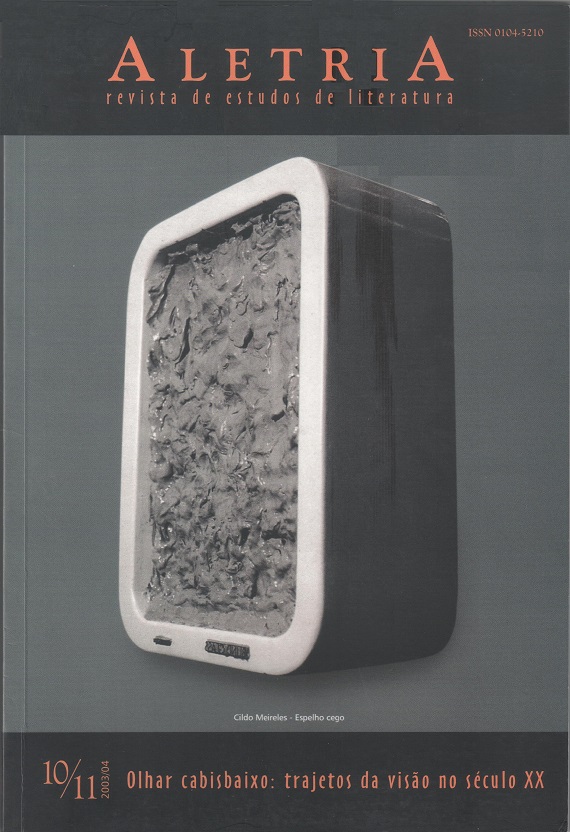A rebelião das máquinas: a arte na era da comunicação aparativa
DOI:
https://doi.org/10.17851/2317-2096.10..144-159Keywords:
arte, técnica, mediatização, art, technique, mediatization.Abstract
Resumo: O presente artigo contribui para uma reflexão sobre a influência da técnica sobre as artes na Era da Informatização. Desde o início da Era Industrial, nota-se a inversão gradativa de papéis entre máquina e homem: a "ascensão das máquinas" teria transformado o homem em "servo". Nem mesmo o campo das artes esteve livre dos efeitos de tal "ascensão", sobretudo no contato com os meios de comunicação de massa, como o rádio, o cinema e a televisão. Na verdade, tudo não passou de um prelúdio para o que ainda estava por vir: a informática atingiu as artes e nossa cultura fundada na tradição escrita, resultando em transformações muito mais amplas no âmbito da comunicação individual e social.
Palavras-chave: arte; técnica; mediatização.
Abstract: The present article brings up issues on the influence of technique on art in the Information Age. Since the beginning of the Industrial Age, there has been a progressive inversion of roles in the relation between man and machine : the "rise of machine" seems to have turned man into a "servant". Not even the field of art remained untouched by the effects of such "rise", specially in its contact with communication media like radio, cinema and television. In fact, all that was but a prelude to what was still to come: informatics reached into the arts and our writing based culture, causing widespread transformations in the realms of social and individual communication.
Keywords: art; technique; mediatization.
Downloads
References
ANDERS, Günther. Die Antiquiertheit des Menschen. Bd. 1 (zuerst 1956). 6. Aufl. München, 1983.
BELLAMY, Edward. Looking backward 2000-1887. Boston, 1888.
BELLAMY, Edward. Ein Rückblick aus dem Jahre 2000 auf 1887. Georg von Gizycki u.d. T. Stuttgart, 1983.
BENJAMIN, Walter. Das Kunstwerk im Zeitalter seiner technisch en Reproduzierbarkeit. In: Illuminationen. Frankfurt a. M., 1969.
BIRKERTS, Sven. TransAtlantic, edição online do Atlantic de 10 set. 1998.
EIMERT, Herbert. Epitaph für Aikichi Kuboyama. Komposition für Sprecher und Sprachklange. Tradução da epígrafe para o alemão: Günther Anders. 6 Studien. Koln: Studio für elektronische Musik im Westdeutschen Rundfunk. Wergo Schallplattenverlag Baden-Baden: 1962. republicado em CD: Koch/Schwann 1996.
FREYERMUTH, Gundolf S. CyberArt Now! Kunst wird spannend: Cyberartisten gestalten den Datenraum. Magazin für Computer technik 1998. Caderno 17, p. 76-81.
HUYSMANS, Joris-Karl. Là-Bas (primeiro 1891). Paris: Plon, 41. Éd., 1921.
LEVINE, Bettijane. Can't curl up with a Cyberbook? Think again. Los Angeles Times, 4 set. 1998.
LORENZ, Dagmar. Der Cyberschreiber und sein Golem. Mark Amerika erfindet Literatur im Internet neu. DIE ZEIT, Nr. 16, 8 abr. 1998, p. 77.
PFLUGRADT, Elke. Maschinenerotik bei van de Velde, Scholz, Klapheck. In: Die nützlichen Künste, ed. por Tilman Buddensieg e Henning Rogge. Berlin 1981, ilustração, p. 375 e 376.
ROLLAND, Romain: La révolte des machines ou la pensée déchainée. Paris, 1921.
SARTRE, Jean Paul. Critique de la raison dialectique I. Paris, 1960.
SIMMEN, René (Org.). Der mechanische Mensch. Texte und Dokumente über Automaten, Androiden und Roboter. Zürich, 1967.
Downloads
Published
How to Cite
Issue
Section
License
Copyright (c) 2003 Eberhard Lammert (Autor)

This work is licensed under a Creative Commons Attribution 4.0 International License.
Authors who publish with this journal agree to the following terms:Authors retain copyright and grant the journal right of first publication with the work simultaneously licensed under a Creative Commons Attribution Non-Commercial No Derivatives License that allows others to share the work with an acknowledgement of the work's authorship and initial publication in this journal.Authors are able to enter into separate, additional contractual arrangements for the non-exclusive distribution of the journal's published version of the work (e.g., post it to an institutional repository or publish it in a book), with an acknowledgement of its initial publication in this journal.Authors are permitted and encouraged to post their work online (e.g., in institutional repositories or on their website) prior to and during the submission process, as it can lead to productive exchanges, as well as earlier and greater citation of published work (See The Effect of Open Access).





